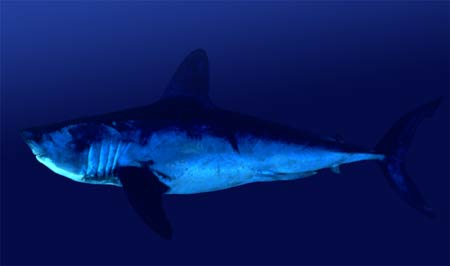
|
|
|
|
|
|
Shark Info (09-15-2001) |
Author |
|
Intro: |
Shark Info |
|
Main article: |
Dr. E. K. Ritter |
|
Article 1: |
Nihal Özkara |
|
Article 2: |
Jürg Brunnschweiler |
|
Article 3: |
Harald Gay |
|
Fact Sheet: |
Dr. E. K. Ritter |
|
Fact Sheet: Mackerel Sharks
Mackerel sharks received their name because of their preferred prey which is mostly herring, but also comprises such related fish species as mackerels and sardines. Many years back mackerel sharks were widely distributed in the North Atlantic. Today they must be categorized as highly threatened. The biology of the mackerel shark (Lamna nasus)DescriptionThe mackerel shark resembles the white shark (Carcharodon carcharias). It has a spindle-shaped body and a very pointed (conical) snout. Contrary to the white shark this species has two keels on the tail fin and the free back end of the first dorsal fin is white. Their teeth are very pointed, while those of the white shark are triangular. Size and AgeThe maximum size of a mackeral shark is about three meters. Rumors which claim they can reach more than 3.5 meters have not yet been confirmed. Their maximum age is unknown although it is presumed to be around 30 years old. FeedingMackerel sharks feed mainly on pelagic schoolers such as herring, sardines and mackerels. They also eat cod and other gadoids as well as smaller shark species (found in stomach analyses). ReproductionAs with all representatives of the Lamnidae family mackeral sharks are ovoviviparous, giving birth to live pups. They also demonstrate a type of uteral cannibalism, eating fertilized eggs rather than embryos. One female gives birth to 1 or 5 pups. The newborn reach a size of 60 to 75 cm. Mackerel shark are mature at approximately age 5. The breeding grounds are assumed to be located off the coast of the U.S. and Europe. Mating time in the North Atlantic appears to be late summer. DistributionThe species prefers the cool waters of the North Atlantic (less than approx. 18°C), but they are also found in the Mediterranean. In the southern hemisphere they have been observed in the southern part of the Indian Ocean around South Australia, off the coast of Chile and in additional regions of the subantartic. BehaviorThis species has been seen to swim alone or in schools (also see "Meaningful usage or overexploitation?" in this issue) either directly underneath the water's surface or in greater depths (up to about 350 meters). Based on earlier catch statistics and research findings they presumably live at least partially separated according to age and sex. Danger to humansAlthough this species is generally classed as being dangerous in relevant literature, no real confirmation of this can be found. ThreatMackerel sharks were fished in the North Atlantic at the beginning of the 70s and were almost wiped out in the mid-80s. Those caught in the North Atlantic in the middle of the year 2001 are the first indication that several animals are still around in the area where they are usually found. May be published only by indicating the source: Shark Info / Dr. Erich K. Ritter |
|
|
|
|
|
|||||
